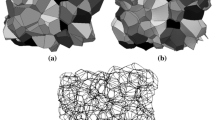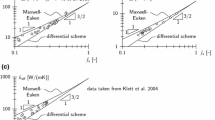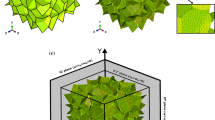Abstract
It is often desirable to predict the effective thermal conductivity (ETC) of a homogenous material like open-cell foams based on its composition, particularly when variations in composition are expected. A combination of five fundamental simplified thermal conductivity bounds and models (series, parallel, Hashin–Shtrikman, effective medium theory, and reciprocity models) is proposed to predict ETC of open-cell foams. Usually, these models use a parameter as the weighted mean to account the proportion of each bound arranged in arithmetic and geometric schemes. Based on ETC data obtained on numerous virtual Kelvin-like foam samples, the dependence of this parameter has been deduced as a function of morphology and phase thermal conductivity ratio. Various effective thermal conductivity correlations are derived based on material properties and foam structure. This is valid for open-cell foams filled with any arbitrary working fluid over a solid conductivity of materials range (\(\lambda_{s} /\lambda_{f}\) = 10–30,000) and over a wide range of porosity (0.60 \(< \varepsilon_{o} <\) 0.95). Arrangement of series and parallel models together using the simplest models for both, arithmetic and geometric schemes, is found to predict excellent results among all the generic combinations.






Similar content being viewed by others
Abbreviations
- µCT:
-
Micro-computed tomography
- ETC:
-
Effective thermal conductivity
- EMT:
-
Effective medium theory
- HS:
-
Hashin–Shtrikman
- LBM:
-
Lattice Boltzmann method
- RT:
-
Reciprocity theorem
- \(A\,or\,R\) :
-
Side length of strut shape or radius of strut shape (mm)
- \(L_{c}\) :
-
Node-to-node length (mm)
- \(L_{s}\) :
-
Strut length (mm)
- \(F\) :
-
Correlation factor (Eq. 30)
- \(R_{eq}\) :
-
Equivalent circular strut radius (mm)
- \(\varepsilon_{o}\) :
-
Open porosity
- \(\varepsilon_{t}\) :
-
Total porosity
- \(\alpha_{eq}\) :
-
Ratio of equivalent circular strut radius to node-to-node length
- \(\beta\) :
-
Ratio of strut length to node-to-node length
- \(\delta\) :
-
Functional parameter in arithmetic scheme (Eq. 7)
- \(\delta^{\prime }\) :
-
Functional parameter in geometric scheme (Eq. 8)
- \(\psi\) :
-
Dimensionless geometrical parameter (Eq. 23)
- \(\eta\) :
- \(\eta^{\prime }\) :
-
Dimensionless fitting parameter (Eq. 28)
- \(\lambda_{s}\) :
-
Intrinsic solid phase conductivity of foam (W m−1 K−1)
- \(\lambda_{s}^{B}\) :
-
Solid/Bulk phase conductivity of foam material (W m−1 K−1)
- \(\lambda_{f}\) :
-
Fluid phase conductivity (W m−1 K−1)
- \(\lambda_{eff}\) :
-
Effective thermal conductivity (W m−1 K−1)
- \(\lambda_{parallel}\) :
-
Effective parallel thermal conductivity (Eq. 1) (W m−1 K−1)
- \(\lambda_{series}\) :
-
Effective series thermal conductivity (Eq. 2) (W m−1 K−1)
- \(\lambda_{HS, Upper}\) :
-
HS upper bound thermal conductivity (Eq. 3) (W m−1 K−1)
- \(\lambda_{HS, Lower}\) :
-
HS lower bound thermal conductivity (Eq. 4) (W m−1 K−1)
- \(\lambda_{EMT}\) :
-
Effective medium theory thermal conductivity (Eq. 5) (W m−1 K−1)
- \(\lambda_{RM}\) :
-
Reciprocity model (Eq. 6) (W m−1 K−1)
References
Calmidi VV, Mahajan RL (1999) The effective thermal conductivity of high porosity fibrous metal foams. ASME J Heat Transf 121(2):466–471
Bhattacharya A, Calmidi VV, Mahajan RL (2002) Thermophysical properties of high porosity metal foams. Int J Heat Mass Transf 45(5):1017–1031
Solorzano E, Reglero JA, Rodriguez-Perez MA, Lehmhus D, Wichmann MA, De Saja JA (2008) An experimental study on the thermal conductivity of aluminium foams by using the transient plane source method. Int J Heat Mass Transf 51:6259–6267
Dietrich B, Schell G, Bucharsky EC, Oberacker R, Hoffmann MJ, Schabel W, Kind M, Martin H (2010) Determination of the thermal properties of ceramic sponges. Int J Heat Mass Transf 53(1):198–205
Yang XH, Bai JX, Yan HB, Kuang JJ, Lu TJ, Kim T (2014) An analytical unit cell model for the effective thermal conductivity of high porosity open-cell metal foams. Transp Porous Media 102:403–426
Wang M, Pan N (2008) Modeling and prediction of the effective thermal conductivity of random open-cell porous foams. Int J Heat Mass Transf 51(5–6):1325–1331
Coquard R, Rochais D, Baillis D (2012) Conductive and radiative heat transfer in ceramic and metal foams at fire temperatures. Fire Technol 48:699–732
Mendes MAA, Talukdar P, Ray S, Trimis D (2014) Detailed and simplified models for evaluation of effective thermal conductivity of open-cell porous foams at high temperatures in presence of thermal radiation. Int J Heat Mass Transf 68:612–624
Miettinen L, Kekalainen P, Turpeinen T, Hyvaluoma J, Merikoski J, Timonen J (2012) Dependence of thermal conductivity on structural parameters in porous samples. AIP Adv 2:012101–012115
Kumar P, Topin F, Vicente J (2014) Determination of effective thermal conductivity from geometrical properties: application to open cell foams. Int J Therm Sci 81:13–28
Kumar P, Topin F (2014) Simultaneous determination of intrinsic solid phase conductivity and effective thermal conductivity of Kelvin like foams. Appl Therm Eng 71(1):536–547
Kumar P, Topin F (2014) The geometric and thermohydraulic characterization of ceramic foams: an analytical approach. Acta Mater 75:273–286
Vicente J, Topin F, Daurelle JV, Rigollet F (2006) Thermal conductivity of metallic foam: simulation on real X-ray tomographied porous medium and photothermal experiments. In: Proceedings of IHTC 13, Sydney
Coquard R, Baillis D (2009) Numerical investigation of conductive heat transfer in high-porosity foams. Acta Mater 57(18):5466–5479
Bodla KK, Murthy JY, Garimella SV (2010) Resistance network-based thermal conductivity model for metal foams. Comput Mater Sci 50:622–632
Randrianalisoa J, Coquard R, Baillis D (2013) Microscale direct calculation of solid phase conductivity of Voronoi’s foams. J Porous Media 16(5):411–426
Mendes AAM, Ray S, Trimis D (2013) A simple and efficient method for the evaluation of effective thermal conductivity of open-cell foam-like structures. Int J Heat Mass Transf 66:412–422
Mendes AAM, Ray S, Trimis D (2014) An improved model for the effective thermal conductivity of open-cell porous foams. Int J Heat Mass Transf 75:224–230
Ranut P, Nobile E, Mancini L (2014) High resolution X-ray microtomography-based CFD simulation for the characterization of flow permeability and effective thermal conductivity of aluminum metal foams. Exp Therm Fluid Sci. doi:10.1016/j.expthermflusci.2014.10.018
Wulf R, Mendes AAM, Skibina V, Al-Zoubi A, Trimis D, Ray S, Gross U (2014) Experimental and numerical determination of effective thermal conductivity of open cell FeCrAl-alloy metal foams. Int J Therm Sci 86:95–103
Krishnan S, Garimella S, Murthy JY (2008) Simulation of thermal transport in open-cell metal foams: effects of periodic unit-cell structure. J Heat Transfer 130(2):24503–24507
Druma A, Kharil Alam M, Druma C (2006) Surface area and conductivity of open-cell carbon foams. J Miner Mater Charact Eng 5:73–86
Boomsma K, Poulikakos D (2001) On the effective thermal conductivity of a three-dimensionally structured fluid-saturated metal foam. Int J Heat Mass Transf 44:827–836
Singh R, Kasana HS (2004) Computational aspects of effective thermal conductivity of highly porous metal foams. Appl Therm Eng 24:1841–1849
Leach AG (1993) The thermal conductivity of foams. I: models for heat conduction. J Phys D Appl Phys 26:733–739
Hashin Z, Shtrikman S (1962) A variational approach to the theory of the effective magnetic permeability of multiphase materials. J Appl Phys 33:3125–3131
Landauer R (1952) The electrical resistance of binary metallic mixtures. J Appl Phys 23(7):779–784
Keller JB (1962) A theorem on the conductivity of a composite medium. J Math Phys 5:548–549
Pieper M, Klein P (2012) Application of simple, periodic homogenization techniques to non-linear heat conduction problems in non-periodic, porous media. Heat Mass Transf 48:291–300
Qu ZG, Wang TS, Tao WQ, Lu TJ (2012) A theoretical octet-truss lattice unit cell model for effective thermal conductivity of consolidated porous materials saturated with fluid. Heat Mass Transf 48:1385–1395
Dai Z, Nawaz K, Park Y, Bock J, Jacobi A (2010) Correcting and extending the Boomsma–Poulikakos effective thermal conductivity model for three-dimensional, fluid-saturated metal foams. Int Commun Heat Mass Transf 37(6):575–580
del Rio JA, Zimmerman RW, Dawe RA (1998) Formula for the conductivity of a two-component material based on the reciprocity theorem. Solid State Commun 106:183–186
Takegoshi E, Hirasawa Y, Matsuo J, Okui K (1992) A study on effective thermal conductivity of porous metals. Trans Jpn Soc Mech Eng B 58:879–884
Paek JW, Kang BH, Kim SY, Hyun JM (2000) Effective thermal conductivity and permeability of aluminium foam materials. Int J Thermophys 21(2):453–464
Acknowledgement
The authors would like to thank the ANR (Agence Nationale de la Recherche) for financial support in the framework of FOAM project and all project partners for their assistance.
Author information
Authors and Affiliations
Corresponding author
Rights and permissions
About this article
Cite this article
Kumar, P., Topin, F. Different arrangements of simplified models to predict effective thermal conductivity of open-cell foams. Heat Mass Transfer 53, 2473–2486 (2017). https://doi.org/10.1007/s00231-017-1993-8
Received:
Accepted:
Published:
Issue Date:
DOI: https://doi.org/10.1007/s00231-017-1993-8




